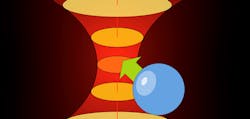New type of optical tweezers reduces laser intensity at focus by up to 100 times
When studying biological cells using optical tweezers, one main issue is the damage caused to the cell by the tool. Giovanni Volpe, University of Gothenburg, has discovered a new type of force that will greatly reduce the amount of light used by optical tweezers, improving the study of biological cells and other particles.
Two different types of forces created by optical tweezers have previously been identified: gradient force (the particle moving against the intensity of the laser) and scattering force (where the particle is pushed towards the laser). Giovanni Volpe and his team pf researchers from Bilkent University (Ankara, Turkey), CNR-IPCF (Messina, Italy) and the University of Gothenburg (Gothenburg, Sweden) have discovered a third type of force in this realm, an intracavity nonlinear feedback force, and as a result, a new way of constructing optical tweezers.1 The method allows very low-numerical-aperture (low-NA) beams, and thus much lower intensity in the focal region.
“The basic idea is that, depending on where the particle or cell you want to study is, the amount of laser light used to trap it changes automatically,” says Volpe. “Whenever the particle is in focus, the laser switches off. When the particle tries to escape, the laser switches on again. With this method, as much as 100 times less light is needed, in some cases, compared to using a traditional optical tweezer.”
The NA of the lens used in the experiment was 0.12, far below the 1.2 NA of the liquid-immersion lenses typically required for optical tweezing. The researchers experimentally trapped polystyrene and silica particles with diameters of 3 to 7 μm.
Source: https://www.gu.se/english/about_the_university/news-calendar/News_detail//a-new-force-for-optical-tweezers-awakens.cid1633080
REFERENCE:
About the Author
John Wallace
Senior Technical Editor (1998-2022)
John Wallace was with Laser Focus World for nearly 25 years, retiring in late June 2022. He obtained a bachelor's degree in mechanical engineering and physics at Rutgers University and a master's in optical engineering at the University of Rochester. Before becoming an editor, John worked as an engineer at RCA, Exxon, Eastman Kodak, and GCA Corporation.

